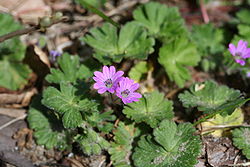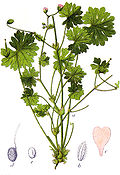From Wikipedia
Open on Wikipedia
| Geranium molle | |
|---|---|

| |
| Scientific classification | |
| Kingdom: | Plantae |
| Clade: | Tracheophytes |
| Clade: | Angiosperms |
| Clade: | Eudicots |
| Clade: | Rosids |
| Order: | Geraniales |
| Family: | Geraniaceae |
| Genus: | Geranium |
| Species: | G. molle
|
| Binomial name | |
| Geranium molle | |
Geranium molle, the dove's-foot crane's-bill[1] or dovesfoot geranium,[2] is an annual herbaceous plant of the family Geraniaceae.
Description
[edit]Geranium molle is a small plant reaching on average 5–30 centimetres (2.0–11.8 in) in height.[3] It is a very branched plant, quite hairy, with several ascending stems. The leaves are palmate, cut 5 to 9 times. The basal leaves are arranged in a rosette, the upper ones are sessile, rounded and hairy, with a long petiole of about 5–12 millimetres (0.20–0.47 in).[3] The flowers are pinkish-purple, 8–12 mm in diameter, with very jagged petals. It blooms from April to September. The flowers are hermaphrodite and mainly pollinated by Hymenoptera. Fruits are glabrous, usually with 6-9 transverse ridges.[3]
Synonyms
[edit]
|
|
Distribution and habitat
[edit]It is native to the Mediterranean and sub-Mediterranean areas, but has naturalized in other parts of Europe, in southwestern and central Asia and in North Africa, though it may have already been in those parts and areas, just not properly identified.[citation needed] It is considered an introduced species in North America, where it is known as Dovefoot Geranium or Awnless Geranium. Although non-native in parts of its range, this species poses little threat to native ecosystems.[5]
It is found in dry meadows, hedges, banks and forest edges. It prefers sunny places on sandy and relatively dry soils, at an altitude of 0–1,000 metres (0–3,281 ft) above sea level.[3]
Herbal medicine
[edit]Nicholas Culpeper in his herbal of 1652 suggested a variety of uses for G. molle, including the treatment of internal and external injuries. A note was made that the bruised leaf healed external injuries faster. A decoction in wine was said to relieve gout and other joint pains.[6]
Gallery
[edit]-
Figure from Deutschlands Flora in Abbildungen, 1796
-
Plant of Geranium molle
-
Leaves, buds, flower
-
Flowers of Geranium molle
-
Close-up of a flower of Geranium molle
-
Immature fruit
-
Hairy stem of Geranium molle
-
Young leaves of Geranium molle var. Brutium.
-
Leaf colouring from spring (top left) to autumn (bottom right)
References
[edit]- ^ BSBI 2007 list, Botanical Society of the British Isles, 2007, archived from the original on 2009-07-07, retrieved 2012-02-02
- ^ Pojar and MacKinnon (1994), Plants of Coastal British Columbia
- ^ a b c d Pignatti S. - Flora d'Italia – Edagricole – 1982. Vol. II, pag. 10
- ^ Synonyms from Catalogue of life[permanent dead link]
- ^ E-FLORA BC: ELECTRONIC ATLAS OF THE FLORA OF BRITISH COLUMBIA
- ^ Culpeper, Nicholas (1652), The English physitian: or an astrologo-physical discourse of the vulgar herbs of this nation, London: Peter Cole
External links
[edit]- Universiteit Leuven Photo gallery Archived 2011-10-03 at the Wayback Machine
- Jepson Manual Treatment
- U.C. Photo gallery
- Geranium molle Flowers in Israel








